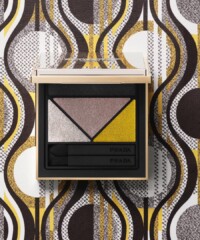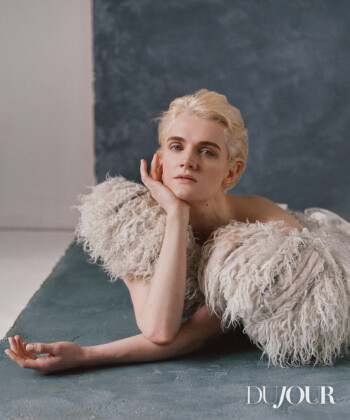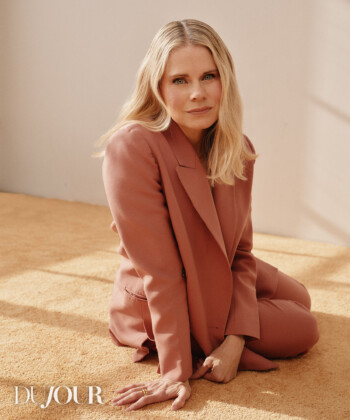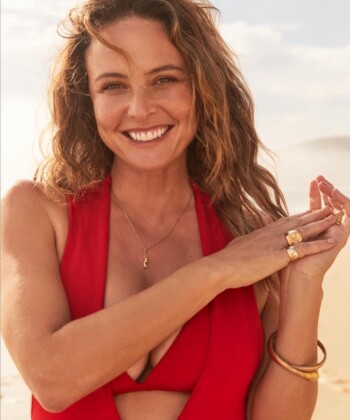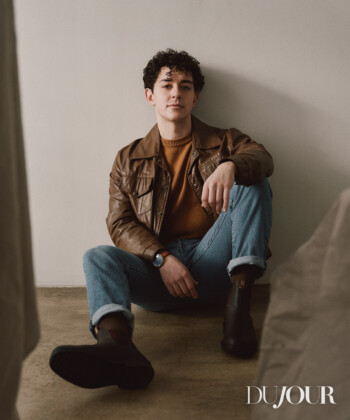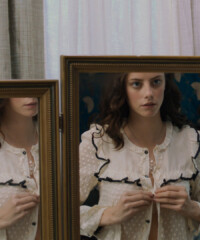When Isabella Rossellini’s Green Porno first debuted on the Sundance Channel in 2008, it was, to say the least, an unexpected bit of programming. The star of Blue Velvet and former face of Lancôme dressed up as various insects and fish, acting out their strange reproductive rituals? It was startling, but also educational—and exceedingly funny.
Beginning January 16, Rossellini will bring her buggy brand of humor from the TV screen to the proscenium stage when Green Porno lands at the Brooklyn Academy of Music for a 10-day run.
DuJour spoke with Rossellini about adapting the show to the stage, nurturing her interest in mating rituals and what’s so very wonderful about sequential hermaphrodites.
You’ve been a model, an actress, and author and an activist. How did you decide to become the lady who talks about bug sex?
I’ve been doing it for almost six years, and it came as an experiment for a contest for the Internet commissioned by Sundance Channel—that’s how it started. The films [I made] found a wide audience on the Internet, and so they ended up on television, they ended up in festivals, and I was commissioned a total of 40 episodes. Now it has evolved into this model of the theatre.
When was your interest in this subject matter first piqued?
I was always interested in animals, specifically animal behavior, so it was always a hobby of mine. So, when I started writing and directing films, I wrote and directed about what was interesting to me, so it was about animals. Some people that knew me as a model or knew me as an actress were surprised by it, but my family wasn’t surprised by it. They heard me talking about these things since I was a little girl!
What have the challenges been for you translating this into a work onstage?
It was less challenging because I had Jean-Claude [Carrière, screenwriter] to help me do it, whereas with the films, I wrote by myself. It was wonderful to have Jean-Claude, because he could go more in depth about certain subjects although I wanted to always play funny; it was very important to me that my piece be entertainment, not just educational. But there is an element of education because all that we say is effectively correct. The challenge is to take things that are written in scientific terms that are very dry and make them funny.
One of the things that I’ve been most impressed by is the costuming, because while the costumes certainly seem to be correct, they’re also really hilarious.
The costumes are a big part of it. I think when you see the costumes, you understand that I have more experience in fashion; these costumes to me were an extension of haute couture.
What’s been the most difficult costume to wear?
Probably the earthworm. It was the most uncomfortable because it was very, very long. It was 35 feet long and I had to be wrapped up, so I didn’t have my hands. Most of the time when I wear other costumes, my hands are free so I can drink some water or I can scratch my nose if it itches, but the worm I had to be sort of wrapped, all of my body, so I didn’t have hands. I couldn’t drink, I couldn’t scratch, I couldn’t do anything. Generally for each episode it takes about all day to film, and I might be in the costume most of the day, so the worm—Oh, my God, I went hysterical—it was so difficult, that costume was torture.
With a piece like this, you’re going to spark imaginations. Are people always coming up to you to try and talk about insects and their mating rituals?
Most people don’t know about it, I mean sometimes they do, but most of the people are surprised because this information has not been given to us. It’s probably been given to us at school, but they use euphemisms because everyone’s afraid to say the word vagina or penis. So part of it is to explain it simply. Sometimes scientific names are very funny.
You know, there are hermaphrodites but there are also sequential hermaphrodites. Sequential hermaphrodites are animals that change sex in their lifetime, and I think that being sequential hermaphrodites is wonderful. There are animals that give birth by parthenogenesis, meaning that they can even have virgin births. And the whole virgin births—I’ve always loved that name. I always extrapolate these very funny names that scientists have given and put them in because it’s amusing.
Of all the animals that you’ve worked on, which do you think has the most fascinating technique?
The most fascinating thing to me is the fact that there are so many different ways [to mate]. I think that’s the most fascinating is the diversity. It’s the different ways to solve one problem. How do I have babies? How do I replicate the species? All the ways that there are about going, I don’t think there’s one that’s more interesting than the other, it’s just the array of possibilities that makes it so funny.
MORE:
Peter Shire: Icon in the Remaking
Robert Lee Morris Renaissance
Fiona Shaw Talks Poetry, Performance, and True Blood




























